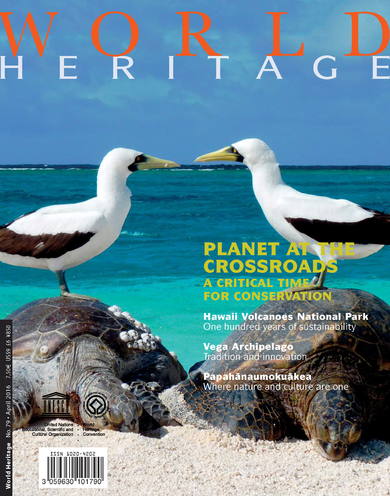From 1 to 10 September 2016, thousands of leaders and decision-makers from government, civil society, indigenous peoples, business and academia will gather together in Honolulu (Hawaii) to share ideas on how to improve the ways we manage the natural environment for human, social and economic development. Held every four years, the IUCN World Conservation Congress (WCC) focuses on joint progress in ways to protect biodiversity, a crucial factor in addressing some of our greatest challenges today, such as tackling climate change and achieving food security.
World Heritage first became an important element of conservation and sustainability plans at the 2003 World Parks Congress in Durban (South Africa), and has been an integral part of WCC congresses ever since. At the Congress in Hawaii, participants will be able to navigate the many Forum events through thematic ‘Journeys’. The Close-up in this issue describes events that will be part of the World Heritage Journey, and includes a list of additional events for the Nature–Culture Journey.
World Heritage sites not only provide models of excellence and best practice in management to be shared with others, but the stakeholders in World Heritage preservation also aim to achieve the highest standards in addressing key issues, including climate change, tourism management and sustainable development.
At the same time, growing threats to the 1,000-plus World Heritage sites force us to work differently. This issue of World Heritage, reflecting this year’s WCC theme of Planet at the Crossroads, highlights progress made through synergies among the seven biodiversity-related Conventions, as well as collaborative work with site managers and national authorities, and enhanced links between natural and cultural heritage. In particular, we look at the ingenious sustainable tourism at Vegaøyan (Norway); applying economic valuation tools to natural World Heritage sites; and the WCC agenda – including a taste of the 1,500 events to be held over four days. We also cover conservation management at the two Hawaiian World Heritage sites, Papahānaumokuākea and Hawaii Volcanoes National Park, and interview Aroha Te Pareake Mead, Chair of IUCN’s Commission on Environmental, Economic and Social Policy.
The World Conservation Congress is not only a meeting place for many World Heritage site managers and national agencies, civil society and non-governmental organizations; it is a forum for exchange, networking and training on the latest conservation tools and technologies. We look forward to many fruitful exchanges and outcomes that will further help us to adapt and orient our efforts for effective conservation work amid a multitude of threats and challenges, in order to confront and overcome them as effectively as possible.
Mechtild Rössler
Director of the UNESCO World Heritage Centre
Table of contents
IN FOCUS, p. 4
Today defines tomorrow: World Heritage as litmus test for action on agreements, p. 4
IUCN is committed to harnessing the support needed to achieve excellence in World Heritage conservation. The IUCN World Conservation Congress in Hawaii will provide the opportunity to take action together.
Hawaii Volcanoes National Park
One hundred years of sustainability, p. 12
Like many other national parks, visitation has increased, visitor and resource protection has become more challenging, and visitor use and enjoyment are more reliant on our partners than before.
Papahānaumokuākea
Where nature and culture are one, p. 18
When Papahānaumokuākea was established in 2006, it became the first marine monument in the United States created expressly to protect both natural and cultural heritage.
Sustainable tourism in the Vega Archipelago, p. 26
An important target area for the Vega World Heritage Foundation is a unique information and interpretation project for children and young people, who are given the chance to experience Vega’s natural and cultural heritage in new ways.
Valuing the invaluable
Applying economic valuation tools to natural World Heritage sites, p. 32
Estimating the total value of a World Heritage site is impossible, but it can be useful to assess and quantify the benefits it provides. This requires a careful approach to ensure economic information is balanced by non-monetary values.
CLOSE-UP, p. 40
What to expect at the 2016 IUCN World Conservation Congress, p. 40
The IUCN 2016 Congress, on the theme Planet at the Crossroads, will take place in Hawaii from 1 to 10 September 2016.
FORUM, p. 46
Interview, p. 48
Interview with Aroha Te Pareake Mead, Chair of the IUCN Commission on Environmental, Economic and Social Policy.
Advisory Bodies, p. 52
ICOMOS: World Heritage cultural landscapes – conservation and sustainability challenges.
Conventions, p. 54
IUCN: at the forefront of the conservation movement; Message from biodiversityrelated conventions: UN Sustainable Development Goals and the CBD Aichi Biodiversity Targets.
NEWS, p. 57
Preservation, p. 58
Arab States tackle natural heritage protection and management; Impetus for World Heritage in the Netherlands; Luang Prabang: model for the future; Heritage impact assessments discussed on sidelines of General Assembly; French Agency for Marine Protected Areas partners with World Heritage Marine Programme; Tunnel scheme at Stonehenge; Periodic Reporting Reflection Survey; Modern heritage in the Arab States; Pacific World Heritage adopts Draft Action Plan 2016–2020; Prince Albert II Foundation joins marine World Heritage; Responsibility to Protect; UNESCO at COP21; New policy on sustainable development; Nomination workshop in Ethiopia.
In Danger, p. 68
Belize bans offshore oil exploration; Efforts to remove East Rennell from Danger List; 900-year-old consecration of Timbuktu mausoleums; Mtskheta: technical assistance needs.
Outreach, p. 72
#Unite4Heritage photo and story contest winner; First World Heritage Youth Forum in Asia urges action; New Patrimonito episode; Youth Volunteers in Palestine; 5th and 70th anniversary celebrations in Viet Nam; Swiss watch manufacturer Jaeger-LeCoultre: a driving force behind the World Heritage Marine Programme’s successes; Youths gather to protect marine biodiversity; The Case of the Lost World Heritage, 17th episode.
IN PRINT AND ONLINE, p. 80










